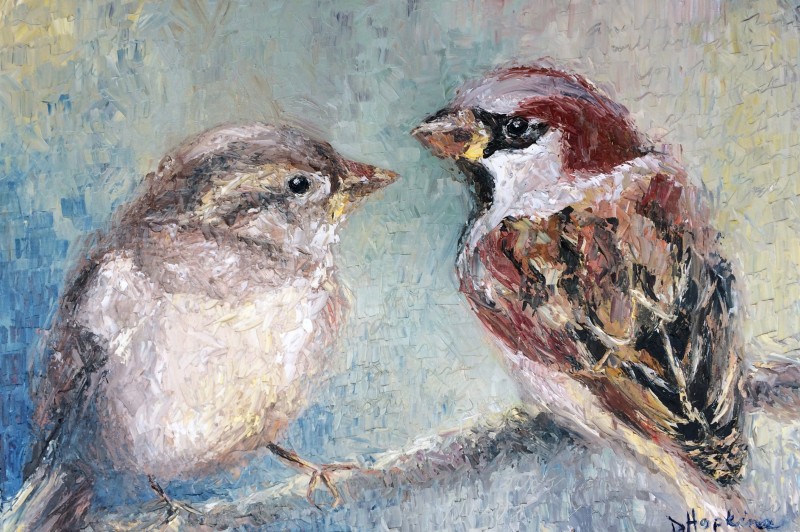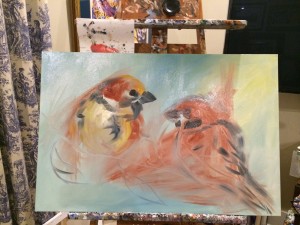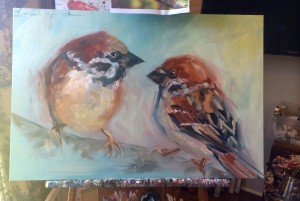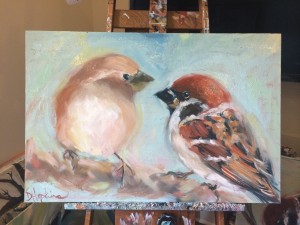Visions and Revisions
Home > Visions and Revisions
“Love Song” 24×36, oil on canvas SOLD
There’s this story about Picasso. I’m not sure if it’s true or not, and I have mixed feelings about it.
A woman spots Picasso at a French cafe. She excitedly recognizes him and asks if he will do a small drawing for her. He quickly sketches a simple image on one of the cafe napkins. Before giving it to her, he asks for an exorbitant fee. Incredulous, the woman responds with something like, “but that drawing only took you a few seconds” and, (here’s where it gets good) Picasso answers with, “No, this took me my whole life.”
Stories like these leave me wondering whether I love Picasso’s conviction, his dedication to his identity as an artist and simply his vast output over the course of a lifetime or if I hate the guy for being so pretentious. Another often quoted Picasso line is this: “My mother said to me, ‘If you are a soldier, you will become a general. If you are a monk, you will become the Pope.’ Instead, I was a painter, and became Picasso”
Damn.
Regardless, what we do is often the result of what we have done– the athlete training versus completing the race or the student studying or learning versus scoring well on a test.
I didn’t start painting until college and I had to take a few design and drawing pre-reqs before I could take a long-awaited painting class. On the first day of my first painting class, I was bright-eyed, eager, and excited for what I knew must be my vocation. My professor, obviously unaware of my extreme and rare talent, remarked that it would take ten years to be “good” at painting. I was incredulous. At twenty, ten years might as well be one hundred.
The more I read about and listen to other artists and the more I work on my own paintings, the more I realize that my professor’s assessment may very well have been quite optimistic. Twelve years later, and I’m just starting to understand a few things. Hell, it takes ten years just to realize your “talent” is nothing unless you use it and that millions of people have similar, perhaps more profound talent. It takes at least ten years to be humbled, and, I’m not sure, but I’m fairly certain humility makes the best playing field for any type of art.
Back in April, I was asked to do a painting for one of my all-time favorite students, Erica. It was to be a wedding gift from her mother.
I met Erica at Morning Call in city park to discuss what she wanted this custom painting to look like. I wrote about it in a blog post April 16. She wasn’t quite sure what she wanted, so our meeting turned into a kind of “these are a few of my favorite things” game– sparrows, flowers, roses, bluebonnets, words. I left feeling good about it. I had this. Piece of cake.
I’d just become interested in birds other than pelicans so I knew this painting was going to involve a sparrow. Besides, city park had been full of them the day we talked. But I wasn’t going to do two birds. Two birds would be too much– too literally “love birds”, too cheesy a wedding gift.
So without a whole lot of planning I set out to do a very large sparrow. And, as I usually do when attempting to paint something for someone other than myself, I complicated it. Wouldn’t it be wonderful if I somehow worked the couple into the painting? I was, at that exact moment, very interested in loose impressionistic figure painting and reasoned a large bird with the impression of a couple at a cafe table far in the distance would be perfect. The result was not quite so perfect, and although I loved the figures, the painting as a whole didn’t come together. It was harsh, disjointed, and not at all joyful. I quit long before it was finished.
I spoke to Erica about it, and she, politely and confidently, confirmed what I already knew– the painting just wasn’t working. I was frustrated but also relieved. Had Erica said she loved it, I might have kept going down a road leading nowhere. I am proud of her for being so frank in her discussions with me. False flattery achieves very little, and I hope to imitate her gracious and still direct communication. I often find myself afraid to voice my authentic thoughts in the face of what I perceive to be someone else’s fragile ego. It’s time for me to start giving others more credit. There is a way to be both kind and critical. Erica is a master at this.
My second attempt at the painting, and I added two birds (Erica’s request), made them smaller, focused more on the cafe scene I’d envisioned. The problem entered when the cafe scene became more prominent– I need far more reference photos than I had. Light? When the figures were not just little impressions, how was I going to accurately depict the light in a scene completely of my own invention? This painting had real promise. I loved the looseness of the birds and the gentleness of the branch on which they perched. But, once again, the various elements of the paintings were not getting along. Visually bickering with one another. It was painful to watch each day in the studio and my sessions were work– like walking miles and arriving farther away than where you started.
Attempt three: scratch everything. Paint the freaking birds. I painted them large, loose, and, as it progressed, this version became one of my favorite paintings of all time.
Unfortunately, I painted two male sparrows and when Erica saw it, she reasonably suggested one be female. Sure, no problem.
It was a huge problem. The loose, fluid energy of the birds disappeared as I changed the coloring of one of them. Again, when I didn’t have a direct reference (the photo on which I was basing the image was of two male birds) I lost some undefinable quality. What began as an effortless, fluid painting became so overworked that it lost its magic.
Again, walking and moving nowhere when I’d started at a sprint. I’d learned though. Rather than spend another moment reworking an overworked (tired looking?) canvas, I promptly bought a new canvas. I was going to keep what I loved about version three, but this time I was going to experiment because if in the first hour it wasn’t going well, I could always go back to versions, one, two, or three.
Perhaps it was due to the frustration of this painting that was giving me more problems than any other I’d attempted in the last twelve years, but I took out the palette knife. In the interims between fighting with one of the many “Erica paintings” I’d found reprieve in palette knife painting which allowed me to sculpt and mold as much as paint. Gooey, visceral, energetic.
The fourth and final version I painted in about four hours total. No, I painted the fourth and final version in twelve years. Because it took me not only four goes, but twelve years of painting to get to it.
I love it. I love the journey it took to get to it. I love the way Erica helped me get there even though it would have been far easier for her to just accept the first version for fear of offending a former teacher.
I love the words carved into the paint– the lines of a poem both Erica and I adore.
I almost didn’t include images of the not-so-successful paintings, but, if I meant what I said about humility, well, then, I’d better show ’em. I hope this vulnerability resonates with someone because it sure as hell is humbling.
“…And time yet for a hundred indecisions,
And for a hundred visions and revisions…”
— T.S. Eliot, “The Love Song of J. Alfred Prufrock”
Denise Hopkins
July 22, 2014
Share Post
blog
Related Blog Posts
Art/Poetry Spotlight: “Fire Kindled Before you were Born”
Fire Kindled Before you were Born, 6×6, oil on canvas Last month, the gallery hosted our first ever poetry night....
🎨 A Father’s Day Gift Guide for Every Kind of Dad (Featuring Fine Art Prints!)
Father’s Day is in a few short weeks. Celebrate the dad in your life with art this year! He has...
New Bird Minis Preview– May 2025!
9 new bird minis will be available first to my VIPS at 8am on May 3 2025. They will all be...

Join the Denise Hopkins Fine Art VIP Club Today
Become a member and enjoy early access to new releases, exclusive discounts, and a new wallpaper for your computer or tablet. Elevate your art journey with us.












5 Responses
Dearest Denise,
I love reading your blogs. I absolutely loved reading this one. Your love, determination, and dedication are all visible in the magnificent paintings you create. We can all learn from what and how you write and create. You have made my daughter so very happy with “Visions and Revisions”! It shines above her fireplace and I treasure that not only will she have this painting forever, but the story behind it as well. Thank you.
Thanks, Angela. It was an absolute pleasure to create this for Erica.